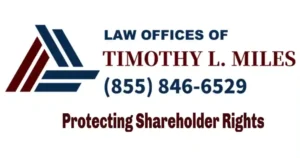Introduction to the Red Cat Class Action Lawsuit
The Red Cat class action lawsuit seeks to represent purchasers or acquirers of Red Cat Holdings, Inc. (NASDAQ: RCAT) securities between March 18, 2022 and January 15, 2025, inclusive (the “Class Period”). Captioned Olsen v. Red Cat Holdings, Inc., No. 25-cv-05427 (D.N.J.), the Red Cat class action lawsuit charges Red Cat and certain of Red Cat’s top current and former executives with violations of the Securities Exchange Act of 1934.
If you suffered substantial losses and wish to serve as lead plaintiff of the Red Cat class action lawsuit, or just have general questions about you rights as a shareholder, please contact attorney Timothy L. Miles of the Law Offices of Timothy L. Miles, at no cost, by calling 855/846-6529 or via e-mail at [email protected]. Lead plaintiff motions for the Red Cat class action lawsuit must be filed with the court no later than July 22, 2025.
Read for answers to the six most frequently asked questions from investors about the Red Cat class action lawsuit.
1. What Is a Corrective Disclosure in a Securities Class Action Lawsuit?
A corrective disclosure in a securities class action lawsuit refers to the release of new information that rectifies or clarifies previous misstatements or omissions made by a company regarding its financial health, operations, or prospects. This disclosure typically emerges after the market has been misled by false or inaccurate statements, causing investors to make decisions based on incorrect data. When the truth comes to light, it often results in a significant drop in the company’s stock price, thereby causing financial harm to shareholders who relied on the prior misinformation.

In the context of a class action lawsuit, such as the Red Cat class action lawsuit, a corrective disclosure is a pivotal element. Plaintiffs must prove that the company’s previous statements were materially misleading and that the corrective disclosure directly caused their financial losses.
The revelation should be substantial enough to demonstrate that investors’ decisions would have differed had they been aware of the actual situation. This process involves examining various factors, including the timing of the disclosure and its impact on stock prices.
Corrective disclosures serve a crucial role in maintaining market integrity and investor confidence. They ensure that companies are held accountable for their public statements and provide a mechanism for aggrieved investors to seek redress.
In cases like the Red Cat class action lawsuit, the court will scrutinize whether the corrective disclosure adequately informed investors of the genuine risks and financial realities that had been previously obscured. Ultimately, corrective disclosures are essential for upholding transparency and fairness within financial markets.
2. What Is the Lead Plaintiff Process Under the PSLRA?
The Lead Plaintiff Process under the Private Securities Litigation Reform Act (PSLRA) is a critical procedure designed to ensure that the most suitable and capable plaintiffs represent the interests of a class in securities litigation. This process begins when a lawsuit, such as the Red Cat lawsuit, is filed, and a notice is published to inform potential class members of the action and their right to move for appointment as lead plaintiff.
The PSLRA mandates that the court select as lead plaintiff the member or members of the purported plaintiff class that it determines to be most capable of adequately representing the interests of class members.

Typically, applicants for lead plaintiff status must file a motion with the court within 60 days of the date on which the notice was published. They are often required to demonstrate that they have a significant financial interest in the outcome of the case and meet other criteria indicating their ability to represent the class effectively.
The court then evaluates the various applicants based on their financial stake, experience in similar litigation, and willingness to oversee the case actively.
Once appointed, the lead plaintiff plays a crucial role in directing the litigation, making strategic decisions, and working closely with lead counsel to ensure that the case proceeds in an efficient and effective manner. This position carries significant responsibility, as the lead plaintiff’s actions can significantly impact all class members’ potential recovery.
In high-stakes cases such as those involving allegations of securities fraud, like the Red Cat lawsuit, having a competent and committed lead plaintiff is essential for achieving a favorable outcome for all affected parties.
3. What False Statements and Material Omissions Are Alleged in the Red Cat Lawsuit?
The Red Cat lawsuit centers on claims of false and misleading statements made during the Class Period. Legal documents show that executives thought over misrepresenting two key aspects of company operations.
Red Cat’s claims about its Salt Lake City facility’s production capabilities came under scrutiny. The company boasted about its ability to produce “thousands of drones per month” or “tens of thousands of drones per year” throughout 2022. Management confirmed in March 2023 that “The Salt Lake City factory is complete and ready to go” and “We now have the capacity to produce thousands of drones per month”. Plaintiffs claim the reality was starkly different – the facility could only produce 100 drones monthly.
The Red Cat lawsuit also targets Red Cat’s SRR Contract value inflation. The company described the agreement’s worth as “hundreds of millions to over a billion dollars” and showed confidence in generating $50-79.5 million in revenue from this contract in fiscal year 2025. Kerrisdale Capital’s analysis of U.S. Army budget documents revealed the contract’s actual value was just $20-25 million.

The plaintiffs also point out that Red Cat “announced the win without Army approval”, which could affect future negotiations.
The Red Cat lawsuit highlights suspicious insider activities. George Matus, the company’s former CTO who created the SRR-winning drone design, stepped down and sold most of his stock right after securing the Army contract. CEO John Thompson also sold his shares during this time.
The company’s financial statements showed no major capital spending toward building the promised mass production infrastructure, which contradicted their public statements. The defendants’ positive claims about Red Cat’s business operations and future prospects were “materially misleading and/or lacked a reasonable basis at all relevant times”, supporting the securities fraud claims.
5.When Is the Lead Plaintiff Deadline in the Red Cat Lawsuit?
Lead plaintiff motions for the Red Cat class action lawsuit must be filed with the court no later than July 22, 2025. When a securities class action is filed:
- The person who files the first Red Cat lawsuit is required to publish a notice announcing the filing.
- Anyone who wants to be the lead plaintiff on behalf of the class must thereafter file a motion to be appointed as lead plaintiff(s) no later than 60 days after the notice was published.
6.What Are the Eligibility Criteria for Lead Plaintiff Appointment in the Red Cat Class Action Lawsuit?

To be eligible for appointment as the lead plaintiff in the Red Cat class action lawsuit, an investor must meet the following criteria:
- Securities Acquisition: The investor must have purchased or acquired Red Cat Holdings, Inc. (NASDAQ: RCAT) securities between March 18, 2022 and January 15, 2025.
- Financial Losses: The investor must have suffered financial losses as a direct result of the alleged securities fraud perpetrated by Red Cat and its executives.
- Typicality and Adequacy: The investor’s legal claims must be typical of those asserted on behalf of the class, and they must demonstrate their ability to adequately represent the interests of the entire class through experience, resources, and the absence of conflicts of interest.
Contact Timothy L. Miles Today About a Red Cat Class Action Lawsuit
If you suffered losses in Red Cat stock, call us today for a free case evaluation about a Red Cat Class Action Lawsuit. 855-846-6529 or [email protected] (24/7/365).
Timothy L. Miles, Esq.
Law Offices of Timothy L. Miles
Tapestry at Brentwood Town Center
300 Centerview Dr. #247
Mailbox #1091
Brentwood,TN 37027
Phone: (855) Tim-MLaw (855-846-6529)
Email: [email protected]
Website: www.classactionlawyertn.com
Facebook Linkedin Pinterest youtube



